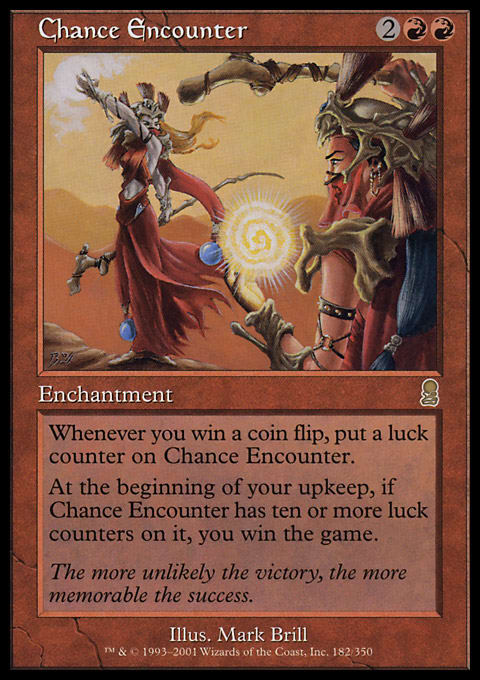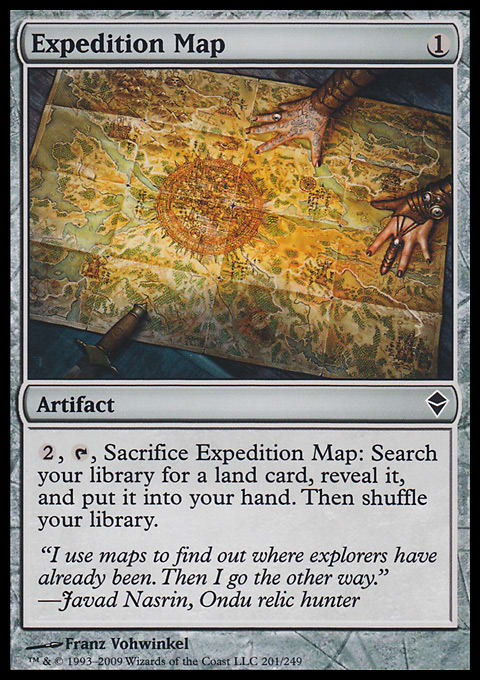We know there are only eight phenomena in the latest version of Planechase, which means there are only seven phenomena that you haven’t seen. Wizards spoiled Time Distortion months ago, but since then, nothing. So far, phenomena have only made the game more random. Reversing the course of the turns is interesting but merely delaying the inevitable (unless you are playing attack right, in which it truly alters the strategy). Interplanar Tunnel fundamentally changes how Planechase plays out.

How Does It Work?
When you roll to planeswalk, you reveal the top card of your planar deck, and Interplanar Tunnel comes up. “When you encounter Interplanar Tunnel, reveal cards from the top of your planar deck until you reveal five plane cards.” Stop here for a second!
At a quick first glance, you read, “show everyone the top five cards of your planar deck,” but this card is doing far more than that. We have phenomena now! You are revealing cards until you reveal five PLANES! Once you do that, you pick one of them, put the rest of the revealed cards bottom of the planar deck in random order, and then put this one on top.
. . . then you planeswalk away from the phenomenon—which means you are picking the plane you want to land on from the top five planes in your deck.
You are tutoring for the plane that you want out of your deck. While each of the decks as sold has only two phenomena, there is nothing in the rules saying you can’t build your planar deck with five phenomena and five planes. Interplanar Tunnel then becomes a second copy of your favorite plane. Since both of the phenomena revealed so far say that you planeswalk away when the action is complete, it stands to reason that every phenomenon will do the same. This will make your ten-card planar deck feel much smaller if this is how it works.
This could allow you to set up a deck of all eight phenomena and two planes! This would make your planar deck very predictable. You will either land on a phenomenon that will let you planeswalk again until you eventually hit Interplanar Tunnel or one of the two planes. Interplanar Tunnel will let you pick either plane or you’ll land on one of the planes. When you planeswalk again, you will have a plane at the bottom of your library. You will either stop at the other plane or draw Interplanar Tunnel before the plane and get to choose either plane. This is far more predictable than the previous best of flipping the next plane in your deck and finding out what it is then!
Before I become too wound up looking at the possibilities, I want to warn you that I didn’t get the spoiler of the rules. With the addition of phenomena to planar decks, deck construction rules will probably change. There may be limits to the number of phenomena permitted in your planar deck, so what I have suggested may not be legal. Since we know there are two phenomena in each deck, we know that they are certainly allowing at least two phenomena per deck.
[Editor's Note: The updated rules for Planar Magic cap the number of phenomenon cards at two, for an individual's own Planar deck, or twice the number of players starting the game, for multiplayer games using one shared Planar deck.]
Even assuming only two phenomena per deck, Interplanar Tunnel at worst puts four planes that you don’t want now at the bottom of your planar deck, bringing you that much closer to the plane you are looking for.
This is a fundamental shift in Planechase. Planechase games have always just been a way to add a further element of chaos to a game that already contains a significant element of luck. With ten planes (at least) in a planar deck, you have no way to control which card comes up next or if you’ll even roll the planeswalk (or chaos) option. Interplanar Tunnel changes this. While you still need to roll to planeswalk, at least you can now have some way to control to where you planeswalk.
This change will appeal to a different type of player who never cared for Planechase. Interplanar Tunnel is a way to limit the variance and bring skill into a part of the game that never had it before. Planechase stops being the sole domain of Magic players who like another element of chaos and expands its appeal.
This isn’t to say that the randomness is gone from the game. Anyone can roll the planeswalk symbol, and all your hard work will go to the bottom of your planar deck (I want to say library so badly!). That luck-sack who rolls three chaos rolls consecutively is still there. Wild and crazy can’t be stopped!
Variants
After discussing how this card limits variance, I want to look at how this will work with Planechase variants. The three main variants are drafting, single deck, and the Map of the Eternities variant.
Drafting
In this variant, you draft all the Planechase cards, and then you build your planar decks with the cards you draft. There are all kinds of way to set up the Drafts, but I won’t go into each of them—the end result is you with a select stack of cards to choose from.
Where you choose Interplanar Tunnel in your draft is very dependent upon your deck and the other cards you’ve drawn. If only a few planes actually help you, you will want to pick the Interplanar Tunnel high in the draft to maximize your options. Unlike Bant and other planes that give a benefit or punish a particular group of cards, this card fits into almost any planar deck. It may turn out that many of the other phenomena will be just as spectacular, but I am blindly predicting it to be drafted high.
Single Deck
This may be the most common way Planechase cards are used. Someone with all the planes—or at least most of the planes—shuffles them up and piles them in the middle. Everyone in the game treats the cards as his or her own planar deck on his or her turn. This is a very popular format because it requires no prep time or knowledge of the Planechase cards. It allows the player(s) who really enjoy Planechase to play with players who never bought cards and have no desire to spend fifteen minutes reading through the options to put together a deck that works with one of his or her preexisting decks.
In this variant, revealing Interplanar Tunnel is a gift. Rather than taking the next card blindly off the top, you are picking the best card for you (or the worst card for everyone else). This will let you advance your strategy (whether that is winning, ending the game, or creating insane board states) better than almost any other option.
Map of the Eternities
This is my favorite variant. Map of the Eternities uses a single deck, but that is where the similarities with the previously discussed variant end. The deck is shuffled up, and the top nine cards are placed in the center of the table in a three-by-three pattern. The middle card and the cards in the horizontal and vertical rows with it are flipped so only the cards in the corners are facedown.
When you get the chance to planeswalk, you can choose to ’walk to any square on the board. If you ’walk to a corner, the card is flipped, and you discover where you landed. Whenever someone moves, all of the cards no long adjacent are removed, and the current plane becomes the center of the 3x3 square with new cards off the top of the deck filling in the open spots on the map, using the same configuration you started with.
This format has the benefits of the single-deck format, but it also gives you some control. You can planeswalk to somewhere beneficial or away from somewhere detrimental—or even to a location just to have a plane or planes taken off the eternities map. This gives you some of the control you get by picking your own planar deck in a regular game without the downside of prep time. Learning the visible planes is much easier than learning all the planes!
There is no rule for phenomena, so I get to make one up right here! I would suggest that they take the same space as any plane, but once it is completed, you draw the top card from the planar deck and place it in the same space that the phenomenon was in on the map. For Interplanar Tunnel, there seem to be two options. The first is to do exactly what it says on the card. The problem is that in the Map of the Eternities format, planeswalking involves traveling to an adjacent spot, so you aren’t necessarily getting the plane that you want. To follow the intent of the card, a better way would be to replace the phenomenon with the plane you picked.
Suggested Uses
As is – Find out which of the decks Interplanar Tunnel is in, and just buy that package. It already comes with a deck (with new cards!) and an all new Planechase deck. You have to expect Wizards made sure there would be synergy between the deck and the planar deck in the same package, right? I can’t promise the power level will be up to your liking, but with zero effort and a few bucks, you can be playing Planechase!
Old-school – Pick up any of the older Planechase decks over at CoolStuffInc.com. Simply add the Interplanar Tunnel to the planar deck, and remove the least useful plane. If you love Dragonlair Spider (the other preview card we’re spoiling today, but then you already knew that, didn’t you?) like I do, check out the R/G Elemental Thunder deck. He will easily slot into that deck. You get style points with the older cards while running the new hotness!
Get off your lazy butt and build it yourself – This isn’t nearly as difficult as it sounds. You can even use a deck you already have and simply pick the planes best suited to your deck. I have an older Dragon Broodmother deck that is waiting for a chance to run the Dragonlair Spider. The deck and the planar deck I would run with it are below.
"Interplanar Tokens"
- Creatures (22)
- 1 Boartusk Liege
- 1 Nest Invader
- 1 Tattermunge Witch
- 3 Emrakul's Hatcher
- 3 Kozilek's Predator
- 3 Overgrown Battlement
- 4 Dragon Broodmother
- 4 Dragonlair Spider
- 1 Reinforced Bulwark
- 1 Steel Wall
- Spells (14)
- 1 Avoid Fate
- 1 Branching Bolt
- 1 Vines of Vastwood
- 2 Evolution Charm
- 1 Hush
- 1 Multani's Decree
- 2 Hull Breach
- 1 Aspect of Mongoose
- 1 Fists of Ironwood
- 1 Splinter Twin
- 2 Awakening Zone
- Lands (24)
- 5 Mountain
- 6 Forest
- 1 Rootbound Crag
- 1 Taiga
- 1 Teetering Peaks
- 2 Shivan Oasis
- 3 Khalni Garden
- 4 Kazandu Refuge
- 1 Hammerheim
- Planes (0)
I’m confident that you can pick out nine planes to go with Interplanar Tunnel. Get on it!
Bruce Richard

























